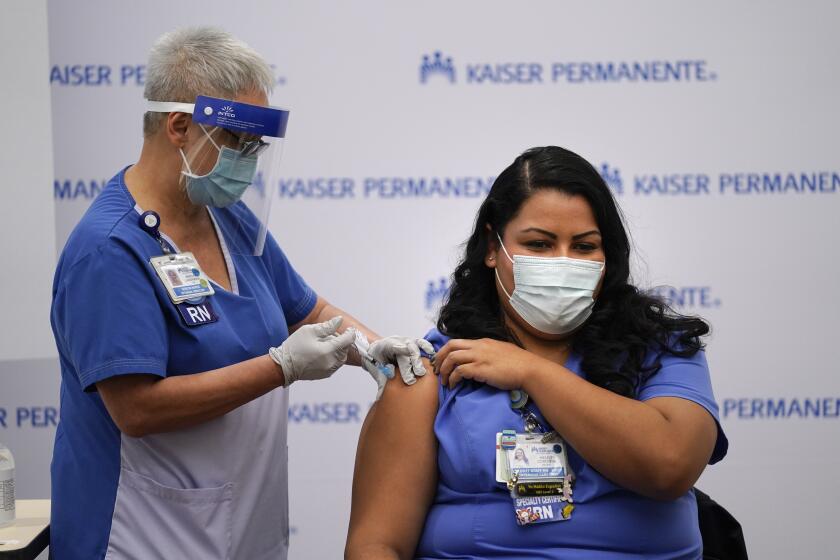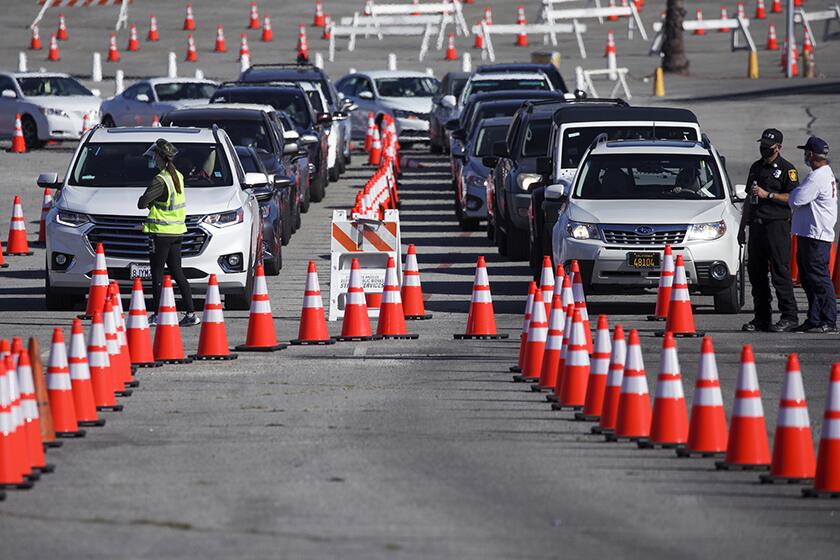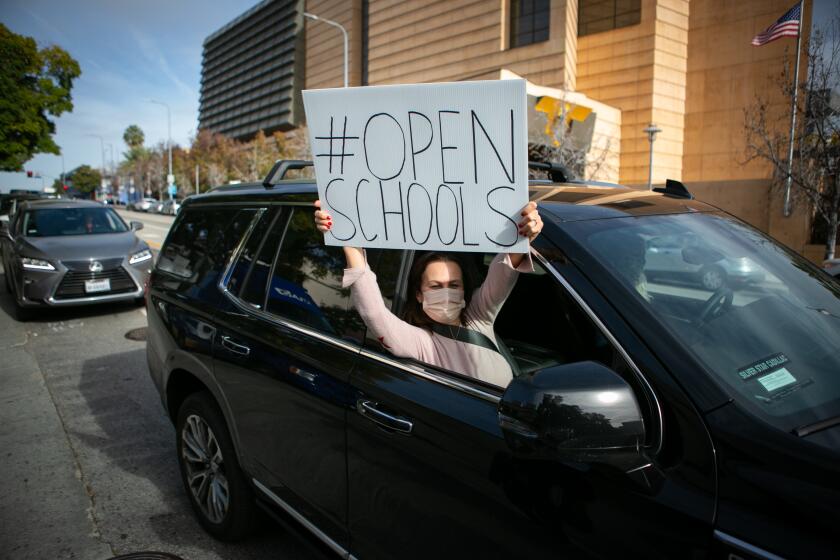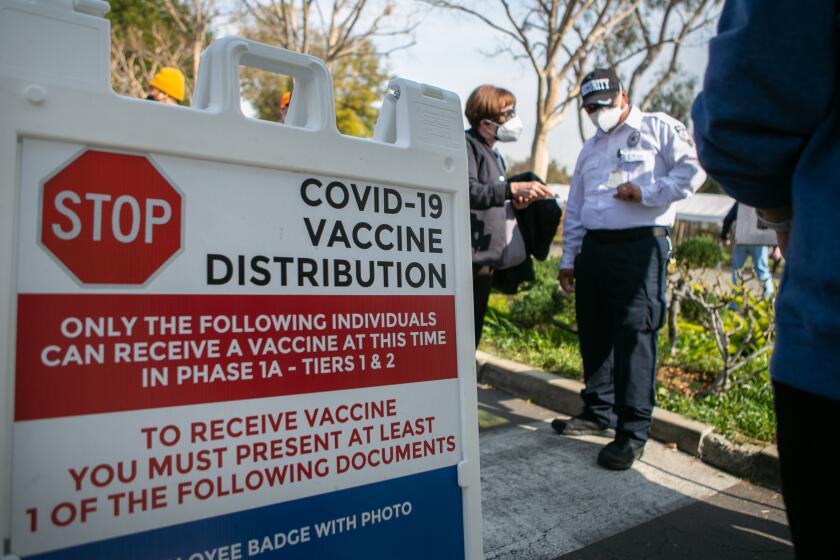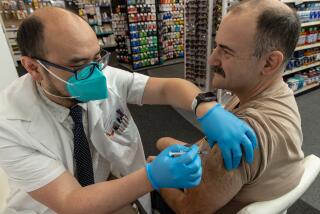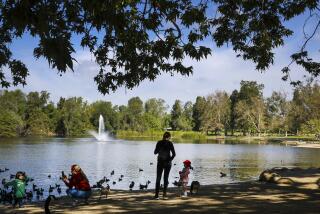L.A. County gets another vaccine site, but supply remains critically low

Speaking at a new vaccine center at Cal State Los Angeles, Gov. Gavin Newsom laid out plans to expand the state’s capacity to administer more vaccines despite the current lag in supply.
Two more COVID-19 vaccination super sites are opening in California, further expanding the state’s capacity to dole out doses even as supplies remain frustratingly limited.
However, officials say the new inoculation centers at Cal State Los Angeles and the Oakland Coliseum will give California a much-needed shot in the arm because the vaccines needed to support them will come directly from the federal government and won’t eat into state allocations.
Even though there aren’t currently enough doses to fully supply the mass vaccination sites that have sprung up across California, Gov. Gavin Newsom said it’s important to establish the capability to handle shipments that are expected to swell over the coming weeks and months as additional doses become available and more vaccines are hopefully approved for use.
“We’re building the infrastructure where the only constraint is supply,” he said Tuesday during an event to mark the opening of the L.A. site. “But when the supply is ample, then we’re able to move aggressively and quickly.”
Any additional vaccines are a welcome development for the state. In recent weeks, Los Angeles County and other parts of California have had to limit the number of appointments for people looking to receive their first vaccine dose in order to ensure they can provide second shots.
That is expected to continue this week.
Blue Shield of California will immediately begin attempting to centralize the state’s COVID-19 vaccination program after a sluggish start.
In Los Angeles, some vaccination sites that were already slated to close Friday because of supply shortages ran out of doses sooner than expected and had to start turning people away Thursday.
“Our city has the tools, the infrastructure and the determination to vaccinate Angelenos swiftly and safely. We simply need more doses,” L.A. Mayor Eric Garcetti said in a statement Monday.
During Tuesday’s event at Cal State L.A., Garcetti said, “We, right now, could do 150,000 doses a day” — many times more than the supply that’s coming in.
“Give us the supply, we’ll be done by July,” he said.
Health officials throughout the state are singing a similar tune. A shortage of supplies forced San Francisco to temporarily pause operations at its Moscone Center and City College vaccination sites, according to a public health statement Sunday.
Mayor London Breed voiced her frustrations on Twitter, writing that San Francisco has shown it “can administer shots as soon as they come in.”
“The only thing holding us back is a lack of supply, and I’m hoping that will change soon,” she continued.
So far, about 8.1 million vaccine doses have been delivered throughout California, and more than 6.1 million have been administered, according to data compiled by The Times.
Both of the currently available COVID-19 vaccines, one from Pfizer-BioNTech and the other from Moderna, require two doses, administered three and four weeks apart, respectively.
Newsom said the state expects to receive about 1.28 million doses this week and 1.31 million next week. That’s an increase above what California has been getting but insufficient to keep pace with recent inoculations — given that 200,000-plus doses have been administered statewide over four of the last five days.
“Do the math. Supply is the issue,” Newsom said.
The sites will be run by the federal government. One will be at Cal State Los Angeles, the other at the Oakland Coliseum.
Cal State L.A.
The new vaccine site at Cal State L.A will have the capacity to vaccinate up to 6,000 people daily for at least eight weeks and is part of a Biden administration effort to roll out 100 vaccination sites nationwide in the first 100 days of the president’s term.
“This is a direct federal allocation separate and apart from what is going to the county,” said Brian Ferguson, spokesman for the state Office of Emergency Services.
Both that site and the second one at the Oakland Coliseum will be jointly run by the state and the Federal Emergency Management Agency.
The two locations were selected, Newsom said last week, to focus on underserved areas devastated by the coronavirus and to ensure that “communities that are often left behind are not left behind.”
Some of the areas surrounding the Cal State L.A. campus have been hammered by the coronavirus.
“This is a big deal to open up this site on the east side of Los Angeles in a community that has been disproportionately impacted by COVID when it comes to infection rates, when it comes to death rates, when it comes to just access to healthcare,” U.S. Rep. Jimmy Gomez (D-Los Angeles) said Tuesday.
As City Councilman Kevin de León put it: “If L.A. is the epicenter for COVID-19, then CD 14” — the council district he represents that covers downtown Los Angeles, including skid row, Boyle Heights, El Sereno and much of Eagle Rock — “is ground zero for infection and mortality rates.”
Churches, social services agencies and other groups will be allocated group tickets for a portion of the vaccines, Ferguson said. The aim is to remove barriers, be they technological, linguistic or other, for people looking to get appointments.
While the foundational goal is to vaccinate as many people as possible, as quickly as possible, officials stress that equity must remain a guidepost of the rollout, as communities of color have borne a disproportionate share of the pandemic’s pain.
The average COVID-19 death rate among Latinos in L.A. County peaked in mid-January at a daily rate of 48 per 100,000 Latino residents, three times that of white residents, which was 16 deaths per 100,000 white residents, according to data released last week.
Black residents in mid-January were dying from COVID-19 at a rate of 23 deaths per 100,000 Black residents; among Asian Americans, the rate was 20 per 100,000 Asian residents.
“This is personal for a lot of us because we’ve seen the devastation in our communities,” Gomez said. “When we see the Latino death rate increase 1,000% since November, we should all be disgusted and offended and appalled. And we should be doing something about it, which we are.”
L.A. County elementary schools are cleared to open, officials confirmed Monday, based on new infection numbers. Meanwhile, the first COVID-19 vaccination site based at an L.A. school will open this week, targeting school district employees.
L.A. schools vaccine site
Right now, most California counties are providing COVID-19 vaccines to people who work in healthcare, live in long-term care facilities or are 65 and older. Some places are also slowly expanding eligibility to certain essential workers, first responders and teachers.
The latter group is of particularly keen interest to parents and policymakers, many of whom are eagerly anticipating the wider reopening of schools for in-person instruction.
However, recent weeks have seen heated debate over whether teachers and other staff need to be vaccinated before that goal can be realized.
Efforts to prioritize L.A. County school staff for COVID-19 immunization took a step forward with the announcement from the L.A. Unified School District that the first vaccination site based at a Los Angeles school will open this week.
Then, school leaders and their supporters — mostly from private schools — organized a demonstration urging the immediate reopening of campuses.
The location for the L.A. Unified vaccinations will be the Roybal Learning Center, just west of downtown Los Angeles, with a scheduled opening Wednesday. Those eligible for immunization will be school district staff 65 and older and district employees currently working at coronavirus testing and vaccination sites, “consistent with current public health rules,” L.A. schools Supt. Austin Beutner said in his weekly broadcast remarks.
Although school nurses of any age, and people 65 and older — regardless of whether they are school employees — have been eligible to receive vaccines elsewhere, the effort at Roybal is the first within L.A. Unified to target school employees. Overall, vaccine doses remain in short supply, and it’s been difficult for many of those eligible to book appointments.
As of Monday, district officials were not certain how many vaccinations would be available this week at Roybal. Participation is by invitation only — and will do little to speed the reopening of campuses that enroll about 465,000 students in kindergarten through 12th grade.
Dodger Stadium and other mass COVID-19 vaccination sites in L.A. are reopening but will focus on second doses due to continuing supply shortages.
L.A. city sites
Dodger Stadium and several other COVID-19 vaccination sites that were shuttered last week amid shortages are set to reopen Tuesday, though continuing supply problems mean the vast majority of shots administered will be second doses, Los Angeles officials said.
People vaccinated in mid-January were automatically slotted into appointments for most of the city’s anticipated weekly supply of 54,000 Moderna doses and 4,000 Pfizer doses, a prioritization that the city said complied with directives by county and federal health officials.
Just 4,600 doses will be set aside for initial immunizations, to be administered at Pierce College and at mobile clinics in hard-hit sections of South and East L.A.
Starting March 15, people ages 16 to 64 who are disabled or at high risk for morbidity and mortality from COVID-19 will be eligible for vaccination.
Eligibility
As health officials work feverishly to keep up with the demand for doses, California is planning to further deepen the eligibility pool next month.
Starting March 15, people ages 16 to 64 who are disabled or at high risk for morbidity and mortality from COVID-19 will be able to receive vaccinations in California — expanding the total number of residents who can get the shots from 17 million to 20 million.
Those who will be eligible in March include those with:
- Cancer, current with debilitated or immunocompromised state
- Chronic kidney disease, Stage 4 or above
- Chronic pulmonary disease, oxygen dependent
- Down syndrome
- Immunocompromised state (weakened immune system) from solid organ transplant
- Pregnancy
- Sickle cell disease
- Heart conditions, such as heart failure, coronary artery disease, or cardiomyopathies (excludes hypertension)
- Severe obesity (body mass index greater than or equal to 40 kg/m2)
- Type 2 diabetes mellitus with hemoglobin A1c level greater than 7.5%
But officials warn that actually getting a shot will be challenging until more supplies are available. Along with additional orders of Pfizer and Moderna vaccines, U.S. drug regulators are reviewing whether to approve a one-shot vaccine produced by Johnson & Johnson for emergency use.
Dr. Anthony Fauci, the U.S. government’s top infectious disease expert, previously said the country could see “open season” for COVID-19 vaccine doses by April. However, in an appearance on “L.A. Times Today,” he said the timeline may be more like “late May and early June.”
“We were expecting a greater number of doses from Johnson & Johnson, and it looks like, even though it’s a good vaccine, that we’re not going to have a substantial amount of doses until we get into April and May,” he said during the program, which is scheduled to air at 7 p.m. Tuesday. “So I think it’s probably going to be a little bit later than the date that I had originally thought because I was not anticipating that we would have this much of a problem with the number of doses.”
However, he still expressed optimism that spring will see “a sharp escalation in the number of people that get vaccinated and very little wait for people to get vaccinated.”
More to Read
Sign up for Essential California
The most important California stories and recommendations in your inbox every morning.
You may occasionally receive promotional content from the Los Angeles Times.
